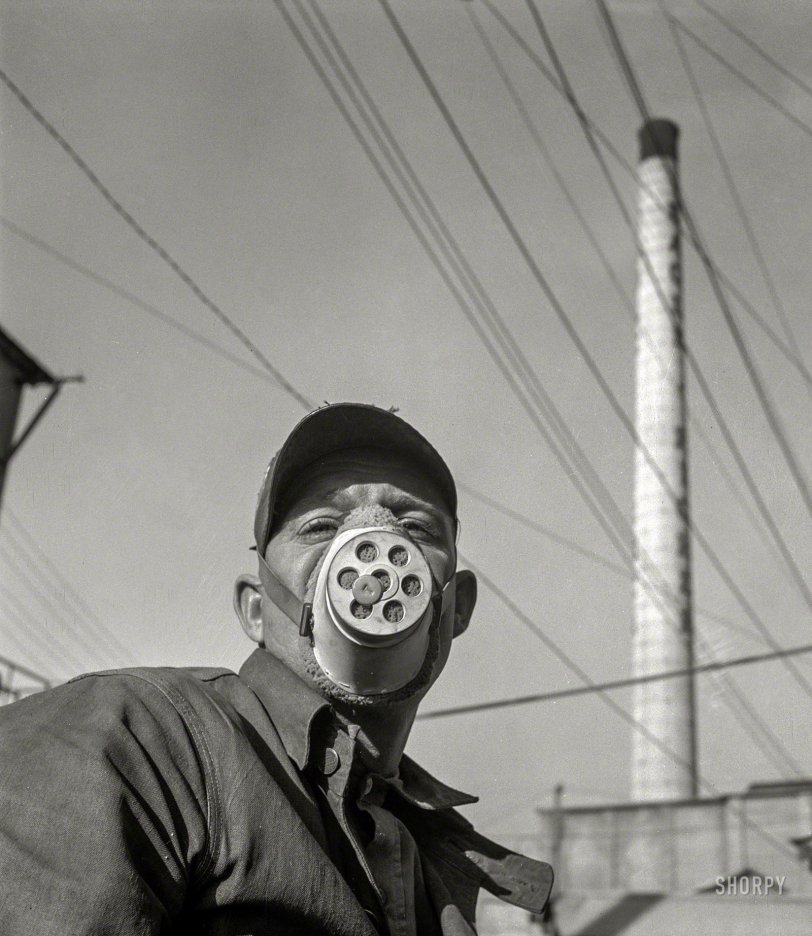


Framed or unframed, desk size to sofa size, printed by us in Arizona and Alabama since 2007. Explore now.
Shorpy is funded by you. Patreon contributors get an ad-free experience.
Learn more.

- Baldwin 62303
- Baldwin VO-1000
- Cold
- No expense spared
- Tough Guys
- Lost in Toyland
- And without gloves
- If I were a blindfolded time traveler
- Smoke Consumer Also Cooks
- Oh that stove!
- Possibly still there?
- What?!?
- $100 Reward
- Freeze Frame
- Texas Flyer wanted
- Just a Year Too Soon
- WWII -- Replacing men with women at the railroad crossing.
- Yes, Icing
- You kids drive me nuts!
- NOT An Easy Job
- I wonder
- Just add window boxes
- Icing Platform?
- Indiana Harbor Belt abides
- Freezing haze
- Corrections (for those who care)
- C&NW at Nelson
- Fallen Flags
- A dangerous job made worse
- Water Stop
Print Emporium
Eagle-Picher: 1943

January 1943. "The operator of a zinc ore loader at a large smelting plant is protected against harmful dust by a mask. From the Eagle-Picher plant near Cardin, Oklahoma, come great quantities of zinc and lead to serve many important purposes in the war effort." 4x5 inch nitrate negative by Fritz Henle for the Office of War Information. View full size.
Getting the lead out
Cardin, Picher, Treece, and other towns in the area are part of the Tar Creek Superfund site, due to all the old lead and zinc mines. There were very high levels of lead in the soil... for a while, the solution for residences was to dig up the first 6 to 12 inches of dirt in the yard and bring in fresh dirt from somewhere else. After that went on for a while, politics happened, and it was decided to be cheaper to write checks to the residents if they would move out of the area. Some people took the checks and moved, and some didn't.
The Tulsa World ran a big story on Picher, and those who wanted to stay, in around March or April 2008. In May 2008, an EF4 tornado hit Picher. It killed six people in town and injured dozens more. That convinced a lot of the holdouts to finally move. Picher quit operating as a city in late 2009, and the last person who stayed passed away in 2015.
The tornado didn't hit Cardin directly, but it was also part of the buyout. Its post office closed in 2009, and the last people moved out in 2010.
The area is still dotted with a moonscape of tailings piles from the mines, which you can see from space at your favorite satellite imagery provider. Before the towns in the area went away, you could drive through there and see local kids riding bikes and ATVs up and down the piles for fun.
If you're ever traveling I-44 in southwest Missouri or northeast Oklahoma, have a little extra time, and would like to do some environmental disaster tourism: from I-44 West, take a slight detour onto US-400 at the Missouri/Kansas/Oklahoma border, go west to US-69 (not Alternate 69), and then south on US-69 through Treece, Picher, Douthat, and Commerce, then to Miami, and back to I-44.
Dirty place
Eagle-Picher eventually started making batteries for space applications. In Tom Kelly's book about building the Apollo Lunar Module, he relates a story about having some battery issues, and going into the facility and finding it filthy - including the guy putting the batteries together wearing dirty farm overalls and smoking in the assembly area. Dust of unknown nature was all over the place. They read them the riot act and they eventually cleaned it up. This was a pretty serious issue, since the only power on the lunar module came from the batteries.
Keep the mask on
Apparently, Eagle-Picher also produced a lot of asbestos and lead. The company went bankrupt and there's now the Eagle-Picher Industries Personal Injury Settlement Trust.
That Look That Says
"Hey--camera man. You really ought to be wearing one of these yourself. Trust me."
























On Shorpy:
Today’s Top 5